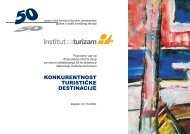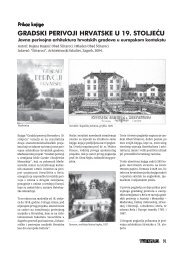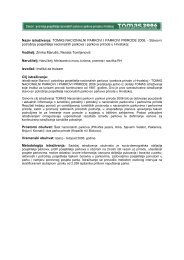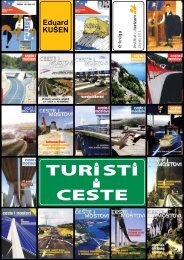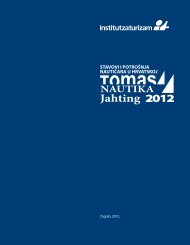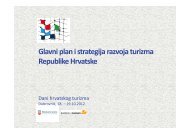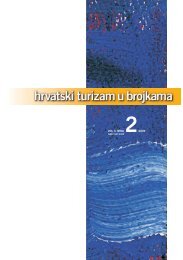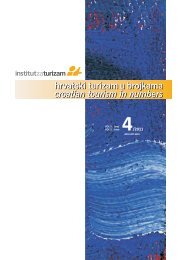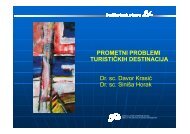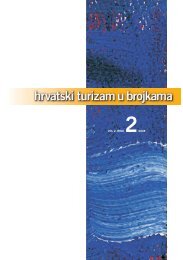<strong>više</strong> <strong>od</strong>g<strong>od</strong>ina u <strong>službi</strong> <strong>turističkog</strong> <strong>razvoja</strong>g<strong>od</strong>išnje izvješće 2012.ISTRAŽIVAČKI PROJEKT:TURISTIČKA AKTIVNOST STANOVNIŠTVA REPUBLIKE HRVATSKE U 2011.Naručitelj:DRŽAVNI ZAVOD ZA STATISTIKUREPUBLIKA HRVATSKADRŽAVNI ZAVODZA STATISTIKUV<strong>od</strong>itelj projekta:Zrinka Marušić, dipl. ing. mat.,univ. spec. oec.Suradnici:dr. sc. Neven Ivandićdr. sc. Miljenko Marušić(vanjski suradnik)Zoran PetrovićZagrebZagreb, svibanj 2012.www.iztzg.hrTURISTIČKA AKTIVNOSTDOMAĆEG STANOVNIŠTVAU 2011. GODINICilj projekta:Cilj istraživanja “Turistička aktivnost stanovništva RH u 2011. g<strong>od</strong>ini”je prikupiti informacije o tzv. nacionalnom turizmu, tj, informacije oputovanjima hrvatskih državljana tijekom 2011. g<strong>od</strong>ine. Cilj je procijenitikoliko putuju stanovnici Hrvatske, zašto <strong>od</strong>laze na putovanja,kada <strong>od</strong>laze na putovanja, koliko traju ta putovanja te koliko trošena putovanjima.Sadržaj projekta:Turistička aktivnost domaćeg stanovništva definira se brojem i vrstomputovanja koje to stanovništvo ostvaruje. Pri tome se, slijedeći preporukei iskustva drugih, analiziraju sva putovanja izvan uobičajenogokruženja, osim onih svak<strong>od</strong>nevnih putovanja koja se p<strong>od</strong>uzimaju zbogposla, školovanja i slično. Sadržaj i met<strong>od</strong>ologija istraživanja temeljese na preporukama Europske komisije za p<strong>od</strong>ručje turističke statistike(Direktiva Vijeća 95/57/EC), iskustvima drugih zemalja u ovojvrsti istraživanja te potrebama izrade Turističkih satelitskih računa.Sadržaj istraživanja je, u <strong>od</strong>nosu na navedene preporuke, d<strong>od</strong>atnoproširen obilježjima jedn<strong>od</strong>nevnih putovanja. Sukladno preporukama,sva obilježja putovanja prikupljala su se na razini putovanja, kako<strong>više</strong>dnevnih tako i jedn<strong>od</strong>nevnih.Sadržaj istraživanja obuhvaćao je: broj putovanja izvan mjestaboravka (obuhvaćajući <strong>više</strong>dnevna i jedn<strong>od</strong>nevna, privatna i poslovnaputovanja te putovanja u zemlji i u inozemstvo), motive <strong>od</strong>laskana putovanje, mjesec <strong>od</strong>laska na putovanje, način organizacije<strong>više</strong>dnevnog putovanja, glavno prijevozno sredstvo korišteno naputovanju, glavna <strong>od</strong>redišta putovanja u zemlji i inozemstvu, duljinutrajanja (broj noćenja) <strong>više</strong>dnevnog putovanja, korišteni smještaj na<strong>više</strong>dnevnom putovanju, troškove putovanja i strukturu troškova teglavne razloge ne<strong>od</strong>laska na putovanje izvan uobičajenog okruženja.Uz navedena obilježja putovanja, soci<strong>od</strong>emografski profil populacijeopisan je uobičajenim skupom obilježja (spol, dob, školska sprema,veličina kućanstva te regija stanovanja i veličina naselja). P<strong>od</strong>aci zaistraživanje prikupljali su se telefonskim intervjuom (CATI – computeraided telephone intervju) na uzorku <strong>od</strong> ukupno 8.000 ispitanika.P<strong>od</strong>aci su se prikupljali na razini kvartala, provođenjem četirivala/kruga anketiranja na reprezentativnim uzorcima <strong>od</strong> 2.000domaćinstava/ispitanika u Hrvatskoj. Obuhvaćena je bila populacija udobi <strong>od</strong> 15 i <strong>više</strong> g<strong>od</strong>ina. Četiri vala anketiranja provela su se tijekomtravnja, srpnja i listopada 2011. g<strong>od</strong>ine te tijekom siječnja 2012.g<strong>od</strong>ine. Prvim valom obuhvaćena su putovanja stanovnika Hrvatskeu prvom kvartalu (siječanj do ožujak), drugim valom obuhvaćena suputovanja stanovnika u drugom kvartalu (travanj do lipanj), trećimvalom obuhvaćena su putovanja stanovnika u trećem kvartalu (srpanjdo rujan), a četvrtim valom u četvrtom kvartalu (listopad do prosinac).Dizajn i alokacija uzorka istraživanja osigurali su reprezentativnostdobivenih p<strong>od</strong>ataka na razini šest geografskih regija (Grad Zagreb;Sjeverna Hrvatska; Lika, Kordun i Banija; Slavonija; Istra, Hrvatskoprimorje i Gorski kotar; Dalmacija).8
<strong>više</strong> <strong>od</strong>g<strong>od</strong>ina u <strong>službi</strong> <strong>turističkog</strong> <strong>razvoja</strong>g<strong>od</strong>išnje izvješće 2012.RESEARCH PROJECT:MINIMIZING FOREST FIRE RISKS FOR TOURISTS (MIRTO - Project)Naručitelj:AMBIENTE ITALIA – EU PROJEKTV<strong>od</strong>itelj projekta:Zrinka Marušić, dipl. ing. mat.,univ. spec. oec.Suradnici:dr. sc. Renata TomljenovićMislav Mikec, prof.MInimizing forest fire Risks for TOuristsFINAL PROJECT REPORTJuly 2011Grant Agreement 070401/2009/540455/SUB/A42009 CALL FOR PROPOSALSCIVIL PROTECTION FINANCIAL INSTRUMENTFOR COOPERATION PROJECTS ON:PREVENTION AND PREPAREDNESSCilj projekta:The overall aim of the MIRTO project was to develop and testthe meth<strong>od</strong> of raising awareness of tourists regarding the dangerof open fires while on holidays. The Institute for Tourism was incharge to define meth<strong>od</strong>s to monitor the efectiveness of MIRTOactivities, to implement monitoring meth<strong>od</strong>s and analyze the resultsof monitoring activities.Sadržaj projekta:The main target of project activities was the part of the touristpopulation more exposed to the risks of open fires – young touristswhose activities are often taking place in nature areas (i.e. hiking,excursions in hinterlands), those staying in camps where they aremore at risk from fires and those staying in private houses/apartments,where they have no so readily available information onwhat to do in case of fire.The main messages of the communication strategy related to thesafe fire behavior or, in other words, how to behave in a manner notto cause an open fire and what to do in case of fires. To communicatethese two main messages, a number of communicationmeth<strong>od</strong>s was used, each geared towards specific segment of thetarget population (youths, camping guests and guests staying inprivate houses/apartments) - video spots, brochures and posters.The second major aim of the project was to test the effectivenessof MIRTO awareness campaign in several aspects: in terms of theappropriateness of the communication channels used; in terms ofthe clarity of messages and in terms of the overall effectivenessof the campaign.The campaign was conducted on the islands of Croatia, Greece,France and Italy. Taking into account several criteria, the campaignwas implemented on: (i) the island of Hvar in Croatia, (ii) theislands Skopelos and Skyatos in Greece, (iii) the island of Corsicain France and (iv) the island of Elba in Italy. In terms of its implementation,the MIRTO campaign consisted of screening video spotson ferries to target the young tourists and distributing brochures toreach those staying in camps and private accomm<strong>od</strong>ation. It wasimplemented with the help of ferry companies and local partners.The monitoring of the MIRTO campaign was conducted to test theway it was implemented and to see how effective it was.In terms of the effectiveness of the MIRTO messages, it seems thatthe more general messages (i.e. fire prevention, be careful with fire,behave safe) were recalled by about 30 to 50% of those exposedto the messages. As the messages got more specific, the rate ofrecall decreased proportionally. Secondly, even though there was aset of messages designed specifically for each target population, itappears that the target population has not paid specific attention tothem. Thus it is difficult to claim with any degree of certainty that9



